Menus
- Own motorcycle drives best
- Braid made of steel tubes with a wall thickness of 2 mm
- Data neck four-cylinder
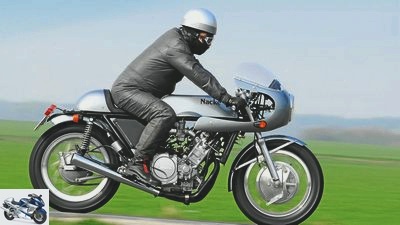
Siemer
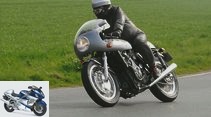
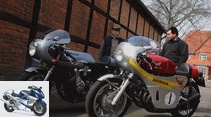
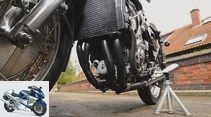

17th photos
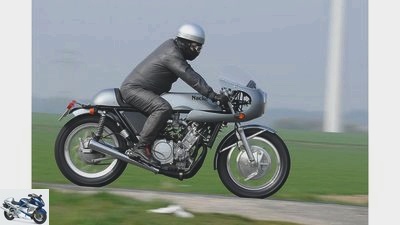
Siemer
1/17
The endless test drives were of course noticed.
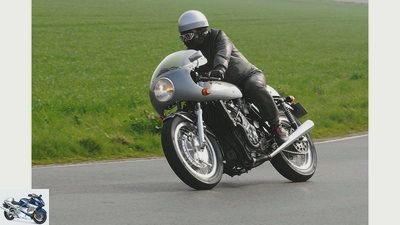
Siemer
2/17
He was influenced by the color scheme.
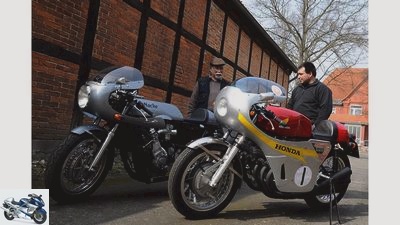
Siemer
3/17
Cord Nacke (left) and son Jens preserve the family treasures. Cord caused a sensation on the Isle of Man as early as 1983 with the six-cylinder Honda.
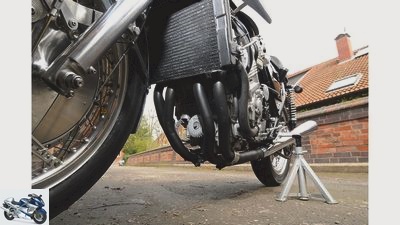
Siemer
4/17
The Yamaha engine hangs under a flat but wide frame bridge, held by two arms of long retaining plates that grip the cylinder head and the standard rear bearings.
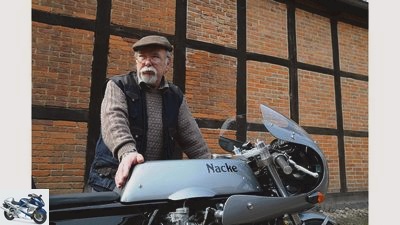
Siemer
5/17
With significant help from his son Jens, a network of steel pipes with a wall thickness of two millimeters was created.
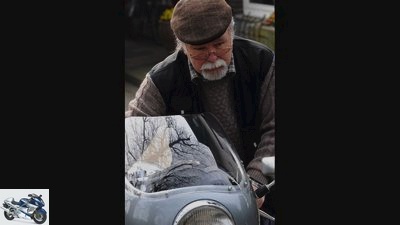
Siemer
6/17
A game at the border between what is feasible and what is sensible, that’s how Nacke describes the search for the right bend and shape of the four flanges that now connect the Italian mixing plants with the Japanese muscle man.
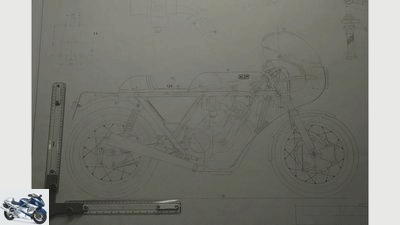
Siemer
7/17
What Cord Nacke had had as a vision since the late 1980s finally reached the concrete planning stage around 2008. Now or never. The draft developed on the drawing board and on DIN-A0. This is where Nacke sorted his ideas, and with a quick glance the morning after, recognized whether he had been thinking in the wrong direction the night before.
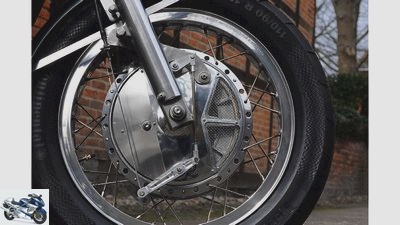
Siemer
8/17
The sturdy 43 mm telescopic fork accommodates the replica of the famous Fontana double duplex brake.

Siemer
9/17
Falling stream was yesterday. With Cord Nacke, the FZR engine breathes through the intake manifold and horizontally positioned Dellortos with an accelerator pump.
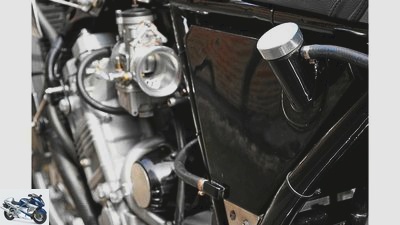
Siemer
10/17
The fuel is stored in the triangle frame, twelve liters are enough for lots of fun.

Siemer
11/17
There is a lot of space under the dummy tank. Also for the distributors of the four throttle cables.

Siemer
12/17
A Nacke four-cylinder should be dedicated to your idea, technically just as clear and aesthetically just as clear, but geared not towards racing success, but towards country road enjoyment.
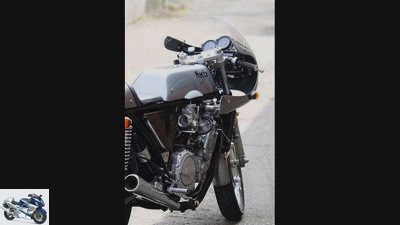
Siemer
13/17
But that wasn’t enough. Cord Nacke had long since chosen the RC 181 as the most beautiful motorcycle in his very own motorcycle world.
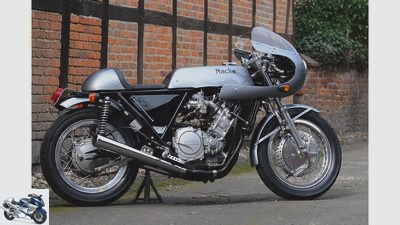
Siemer
14/17
As a young racing fan, he was particularly enthusiastic about the multi-cylinder Hondas, and that’s why, based on the CBX 1000, he built an homage to Mike Hailwood’s six-cylinder RC 174 / RC 166, with which he won the 350 and 250 titles in 1967 had fetched.
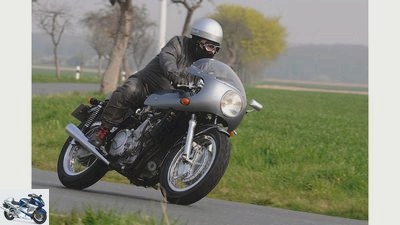
Siemer
15/17
With the self-construction, a great dream of Cord Nacke came true.
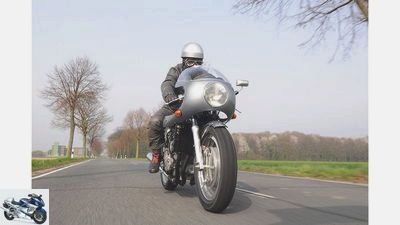
Siemer
16/17
And in the workshop there were happy discussions among friends about what, how and where could still be changed and improved.
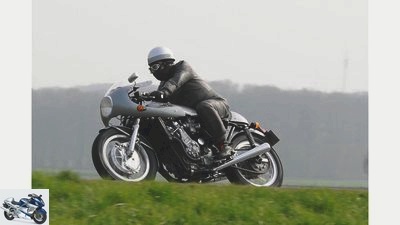
Siemer
17/17
Otherwise his wonderfully aristocratic motorcycle in Laverda orange would be in the yard today.
Self-made with a Yamaha FZR engine
Own motorcycle drives best
Content of
The old driving man Cord Nacke only likes other people’s motorcycles to a limited extent. He’d rather build some himself. Finally, a classic street racer with a powerful four from the Yamaha FZR 1000.
W.How powerful one’s own story can be, everyone notices, in whose gray-framed head the longing for the first Max, RD 250 or even CB 400 flares up again. The time was so beautiful, and as the epitome of it you would at least like to have the motorcycle back. With Cord Nacke, things are basically the same, but the details are much more complicated. The engineer who specializes in environmental technology comes from a true motorcyclist dynasty, over 90 years ago a family member rattled through and around Grob Munzel with an NSU. Before the war, naked father Heinrich was one of the better-known racing drivers in the greater Hanover area, started several times with his Rudge on the Eilenriede, and it was there that Cord, who was born in 1947, got his first taste of racing. It goes without saying that he felt committed to sporty motorcycling.
Buy complete article

Self-made with a Yamaha FZR engine
Own motorcycle drives best
The dream: Honda’s RC 181
Well, Nacke knew what to do and went on with his big dreams. As a young racing fan, he was particularly enthusiastic about the multi-cylinder Hondas, and that’s why, based on the CBX 1000, he built an homage to Mike Hailwood’s six-cylinder RC 174 / RC 166, with which he won the 350 and 250 titles in 1967 had fetched. But that wasn’t enough. Cord Nacke had long since chosen the RC 181 as the most beautiful motorcycle in his very own motorcycle world. The 500cc four-cylinder with which Honda won the constructors ‘title in 1966, but not the drivers’ world championship, and which “Mike the bike” did not lead to success in 1967 – despite being tied with Agostini.
An almost tragic piece of motorcycle history, a myth without a doubt. A Nacke four-cylinder should be dedicated to your idea, technically just as clear and aesthetically just as clear, but geared not towards racing success, but towards country road enjoyment. What Cord Nacke had had as a vision since the late 1980s finally reached the concrete planning stage around 2008. Now or never.
The draft developed on the drawing board and on DIN-A0. This is where Nacke sorted his ideas, and with a quick glance the morning after, recognized whether he had been thinking in the wrong direction the night before. Narrow tires on classic wire spoke wheels, drum brakes, low center of gravity, these were some of the design specifications. And carburetor should of course carry his foursome. Clearly visible, like in the old days. This plan, however, was in contradiction to the desired engine output, because pampered by a current super sports Kawasaki neck hungry for full power – a good 150 hp were targeted. Thus, air-cooled four-cylinder designs were ruled out, after some back and forth, the choice finally fell on Yamaha’s epoch-making five-valve engine from the FZR 1000. And its intake paths, as is well known, protrude steeply upwards in a streamlined manner, the carburettors serve the engine in downflow with an ignitable mixture. So the intake tract would have to put up with some renovation work, and if you were at it, you could replace the standard carburetors with classic 40s Dellortos.

classic
Honda Dream 50
Self-built dream team
read more
Rearview mirror PDF: MOTORRAD self-made Sportstar Touring with R1 engine (MOTORRAD 21/1998)
Braid made of steel tubes with a wall thickness of 2 mm
With significant help from his son Jens, a network of steel pipes with a wall thickness of two millimeters was created. The Yamaha engine hangs under a flat but wide frame bridge, held by two arms of long retaining plates that grip the cylinder head and the standard rear bearings. The rear wheel is guided by a rather narrow swing arm made of rectangular steel tubing, as desired, and the tuning fork chain tensioners also follow the historical dictates. On the other hand, the petrol tank is different, because it is housed – very modern – in the frame triangle and thus contributes to the overall low center of gravity of the machine.
A negative form for the initially planned full cladding was still available, but positive models had to be created for the hump seat bench and the dummy tank. They were created in a laborious layered construction from wood, but of course remained formally bound to the great model. Quasi on the side, Nacke had completely overhauled an FZR engine purchased on the Internet, and now the question of how the mighty Dellortos could be accommodated was gradually pressing. A game at the border between what is feasible and what is sensible, that’s how Nacke describes the search for the right bend and shape of the four flanges that now connect the Italian mixing plants with the Japanese muscle man. Which main, idle and atomizer nozzles would fit?
Were the open velocity stacks too short or too long? How did the exhaust system have to be designed? Exciting coordination work was pending after the engine – with the basic setting of the carburettor – started at the first push of a button on August 1, 2012, but showed neither stable idling nor satisfactory reactions to throttle movements.
Siemer
Cord Nacke (left) and son Jens preserve the family treasures. Cord caused a sensation with the six-cylinder Honda in 1983 on the Isle of Man.
This initial situation barely improved by the winter, but Cord Nacke relentlessly went into the cloudy season: He had enough to do with the GRP parts he had made himself, the spoked wheels also wanted to be prepared. And a new front brake – at least that was what the test drives had shown – had to be found. The 230 mm Grimeca drum did not match the performance that was already available up to then. By chance, Nacke found out about good quality Fontana replicas with a 260 diameter and spontaneously remembered that in the early 1970s some racing drivers had swapped their wonderfully modern disc brakes for this stopper because it was simply more effective. Such a thing was needed, even if the price scratched the pain threshold.
This clarified how the highway burner would come to a standstill. The question remained open as to why it was so stubbornly going, but the answer would be found in spring 2013. Or? After the engine did not respond positively to changes on the carburetor side, the exhaust came under the microscope: Two manifolds each join and flow into a slim Conti silencer. Cord Nacke had deliberately deviated from the Honda template, but now he wondered whether the pressure conditions in his construction were right. He started experiments with interference tubes between the manifolds. No improvement. Almost in an act of resignation, he screwed on the series system of the FZR. For free. All over again, and at last he spotted an improperly drilled atomizer nozzle in one of the carburetors. From now on things went uphill.
The endless test drives were of course noticed. And in the workshop there were cheerful discussions among friends about what, how and where could still be changed and improved. Most of the time Cord Nacke remained steadfast, but he agreed with the opinion that with a slim half-shell his machine would look even more elegant and by no means less classic. He was also influenced by the color scheme. Otherwise his wonderfully aristocratic motorcycle in Laverda orange would be in the yard today.
Data neck four-cylinder
Siemer
A Nacke four-cylinder should be dedicated to your idea, technically just as clear and aesthetically just as clear, but geared not towards racing success, but towards country road enjoyment.
engine
Transversely installed, liquid-cooled inline four-cylinder four-stroke engine from Yamaha, two chain-driven, overhead camshafts, five valves per combustion chamber, bore x stroke 75.5 x 56 mm, compression 12: 1, displacement 1002 cm³, output as standard 145 HP at 10,000 rpm.
Power transmission
Multi-disc oil bath clutch, five-speed gearbox, secondary drive via roller chain.
landing gear
Frame made of steel tubes open at the bottom, welded steering head, rear wheel swing arm made of rectangular steel tube, front fork, stanchion diameter 43 mm, rear stereo struts, wire-spoke wheels with light alloy rims, front tires 110/90 x 18, rear 120/90 x 18, drum brakes, weight approx 190 kg.
Used Yamaha FZR 1000 Exup on markt.motorradonline.de
Related articles
-
BMW R 100, Ducati SD 900 Darmah, Yamaha TR 1 classic motorcycle on tour
29 photos bilski-fotografie.de 1/29 On the move with the BMW R 100, the Ducati SD 900 Darmah and the Yamaha TR 1. bilski-fotografie.de 2/29 On the move…
-
Cult bike Yamaha FZR 1000 Exup
Hartmann Cult bike Yamaha FZR 1000 Exup The blast of 1989 Seldom has a motorcycle been improved so dramatically as the already great Yamaha FZR 1000:…
-
Yamaha XJ 650, XJ 650 Turbo and XJ 900 F in comparison test
Bilski comparison test Yamaha XJ 650 / XJ 650 Turbo / XJ 900 F four-cylinder Yamahas in comparison test Contents of Yamaha’s XJ series are still considered …
-
Yamaha RD 500 LC: Grand Prix replica with V4 two-stroke engine
fact 10 pictures archive 1/10 As elaborately as the engine and chassis were achieved, the cockpit was drawn so simply. Archive 2/10 The 16-inch device makes bends …
-
Kawasaki Z 800 versus Yamaha FZ8 in MOTORCYCLE group test
12th photos 1/12 Yamaha FZ8 versus Kawasaki Z800 in comparison test. 2/12 Clearly structured cockpit, but with…
-
Single cylinder in comparison: Honda XBR 500 and Yamaha SRX 6
Bilski On the move: Honda XBR 500 and Yamaha SRX 6 Single cylinder in comparison: Honda XBR 500 and Yamaha SRX 6 Content of Is less motorcycling more…
-
Honda CB 1000 R, Kawasaki Z 1000 SE, Yamaha FZ1 in the test
www. 48 photos www. 1/48 On the MOTORRAD test tracks in southern France, Honda’s CB 1000 R and Yamaha’s FZ1 are ready to test…
-
GP1 technology: Yamaha YZR-M1 Mixer A new four-stroke in-line engine in the tried and tested chassis of the 500cc two-stroke machine: With this…
-
Honda CBR 650 F, Suzuki GSX 650 F, Yamaha XJ6 Diversion F in the test
fact 46 photos fact 1/46 The Suzuki as a solid all-rounder, the Yamaha as a lively fun bike. Honda is changing the CB 650 F with the casing, on the other…
-
Honda NC 700 S and Yamaha XJ6 ABS in the test
17th photos 1/17 Honda NC 700 S and Yamaha XJ6 ABS in a 48 hp comparison test. 2/17 Honda NC 700 S and Yamaha XJ6…